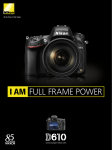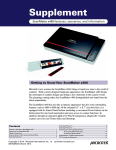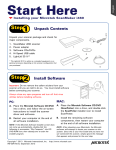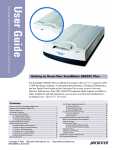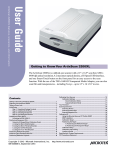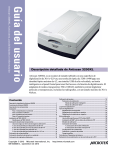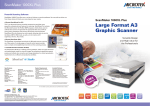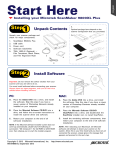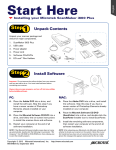Download Microtek ScanMaker i460 Specifications
Transcript
Supplement ScanMaker i460 features, scenarios, and information Getting to Know Your ScanMaker i460 Microtek's new scanner, the ScanMaker i460, brings a brand new taste to the world of scanners. With a newly designed landscape appearance, the ScanMaker i460 breaks the stereotype of scanner designs and brings a new milestone to the scanner world. The gleaming coating makes the ScanMaker i460 distinguishable and stand from the others immediately. The ScanMaker i460 has not only a fantastic appearance but also some outstanding features, such as 4800 x 9600 dpi, 48-bit color, and 8.5" x 11.7" scan bed. Also, it is equipped with six Smart-Touch buttons on the button panel for one-touch automation and easy access to scanner functions. In addition, through an optional LightLid 35 IV transparency adapter, the versatile scanner can even scan 35mm slides and filmstrips. Contents Getting to KnowYour ScanMaker i460 ........................................................... 1 Features of the ScanMaker i460 ...................................................................... 2 Taking a Closer Look ........................................................................................ 3 How the Smart-Touch Scanner Buttons Work .............................................. 4 Scanning Scenarios ......................................................................................... 5 For PC Users Using ScanWizard EZ .......................................................... 6 A. Scanning Photos (1) ........................................................................ 6 B. Scanning Photos (2) ........................................................................ 7 C. Scanning Photos (3) ........................................................................ 9 D. Scanning Film ................................................................................ 11 Copyright © 2013 Microtek International, Inc. I49-004751 B, September 2013 I. Connecting the LightLid 35 IV ....................................................... 11 II. Loading Film ................................................................................... 12 III. Placing the LightLid 35 IV .............................................................. 13 IV. Using the ScanWizard EZ - Advanced Mode ............................... 14 V. Using the ScanWizard EZ - Professional Mode ........................... 16 For Mac Users Using ScanPotter ............................................................ 18 A. Scanning Photos ........................................................................... 18 B. Scanning Film ................................................................................. 20 Specifications / System Requirements ........................................................ 22 FCC Compliance Statement .......................................................................... 23 http://www.microtek.com Features of the ScanMaker i460 The ScanMaker i460 comes with several important features, including the following: • Concise and modern look: With a lustrous coating and new designed format , the ScanMaker i460 is not only a scanner but also a truly classical deco for your taste. The extra light weight and slim machine-body makes the ScanMaker i460 fit to any corners of a room. In addition, it delivers the superior scanned quality as a topperformed scanner may achieve. • Energy-saving LED light source: Adopting LEDs as the light source, when the scanner is detected by the system, there are no requirements for any warm-up time before carrying out the scan, which boots your productivity and reduces energy costs amazingly. With its stable performance, the image quality will remain consistent even after used for a certain period of time. • Microtek's ColoRescueTM system: With ColoRescue, the ScanMaker i460 restores faded colors in photos and film, bringing hues back to their original luster and brilliance for more vibrant images. ColoRescue's one-click, automatic color recovery process is simple and straightforward, involving no learning curve or hassle. • Six Smart-Touch buttons: These buttons on the button panel of the scanner provide you with a quick and easy way to launch frequently used scanner functions. All it takes is one touch of a button — and you can launch the scanner button’s corresponding function. The six Smart-Touch buttons include Scan, Copy, E-mail, OCR, PDF and Web. • Microtek ScanWizard EZ scanning software (PC): ScanWizard EZ is developed exclusively for Microtek scanners used in a PC system. It has three unique scan modes, the EZ mode, Advanced mode and Professional mode that no matter novices and experienced users can find it productive and easy to use. • ScanPotter scanning software (Mac): ScanPotter is a scanning software developed exclusively for Microtek scanners running on a Mac system. ScanPotter has a unique and clean interface that users will find productive and easy to use. • Optional LightLid 35 IV *: This transparency adapter allows you to scan 35mm slides and filmstrips with your scanner. * The LightLid 35 IV is either as a standard equipment or an optional accessory depending on the scanner configuration that you purchased. 2 ScanMaker i460 Supplement Taking a Closer Look Scanner lid Ruler Glass surface (Scan bed) Ruler IV WE B PDF OC R E-M AIL CO SCAN POW PY Button Panel ER WEB WEB PDF PDF OCR OCR E-MAIL COPY SCAN POWER E-Mail Copy Scan Power POWER indicator (orange) READY indicator (green) Hi-Speed USB port (1) Accessory port (9-pin) Power connector ScanMaker i460 Supplement 3 How the Smart-Touch Scanner Buttons Work The Smart-Touch buttons on the scanner simplify frequently performed tasks, such as scanning images or sending scanned images to a printer. By pressing any of the Smart-Touch buttons, you can activate the function associated with that button quickly and easily. For each scanner button, the parameters governing the use of that button are defined or set through the Microtek Scanner Configuration (MSC) utility in your Windows system or through ScanPotter in your Mac OS X system. For instance, you can define how many copies are to be printed of your scan every time you hit the “Copy” button. To launch the MSC utilty, exit ScanWizard EZ first, and then double-click the MSC icon ( ) on your desktop. Note: Make sure that you have exited ScanWizard EZ program before using scanner buttons when you are in Windows system; however, if you are using Mac OS X, you need to activate ScanPotter program before using scanner buttons. The ScanMaker i460 is equipped with six Smart-Touch buttons for easy access to frequently used scanner functions. To carry out a specific task, simply press the corresponding button on the scanner. The Smart-Touch buttons are: 1. Scan: This button captures images that can be automatically saved as files or sent to another application for further processing. 2. Copy: This button scans the image and sends it to your printer, transforming your scanner and printer into a convenient copy station. Simply specify the number of copies you want. To use the Copy button to print a stack of documents: - Place the first page on the scanner glass surface. - Press the Copy button to scan an image to a file, then automatically output to your specified printer. - Load the next page and press the Copy button again. The scanner works in similar fashion to your printer, printing documents one after another with no interruptions. 3. E-mail: This button scans the image and delivers it directly to your e-mail editor. 4. OCR: This button performs OCR (Optical Character Recognition) of a document and converts it to a fully editable digital file. Saves time from retyping documents into your word processor. 5. PDF: This button captures an image and automatically saves it as an Adobe Portable Document Format (PDF) file for immediate viewing with the Adobe Acrobat software. 6. Web: This button scans the image and directly links to your assigned imagesharing website. 4 ScanMaker i460 Supplement Scanning Scenarios The following pages provide various scenarios for scanning with the ScanMaker i460, including the following: For PC Users Using ScanWizard EZ, • Scanning photos (1): This scenario can also be your first scan in order to familiarize yourself with scanning basics. It makes use of the EZ Mode in ScanWizard EZ. • Scanning photos (2): This scenario is similar to that described above but uses the Advanced Mode in ScanWizard EZ. • Scanning photos (3): This scenario details the steps for scanning photos. It makes use of the Professional Mode in ScanWizard EZ. • Scanning film: This scenario details the steps for scanning film. It makes use of the LightLid 35 IV together with the Advanced Mode or Professional Mode in ScanWizard EZ. For Mac Users Using ScanPotter, • Scanning photos: This scenario details the steps for scanning photos. • Scanning film: This scenario details the steps for scanning film. ScanMaker i460 Supplement 5 For PC Users Using ScanWizard EZ A. Scanning Photos (1) This scenario uses the ScanWizard EZ - EZ Mode. IV 1. Raise the scanner lid, and place the photo to be scanned face down on the scanner glass surface. Position the top end of the photo towards the right of the scanner, and then lower the scanner lid on the scanner glass surface. WEB PDF OCR E-MAI L COPY SCAN POWE R Note: For the automatic cropping feature to work correctly during the preview scan of your photo, make sure the scanner lid is completely flat and closed over the scan bed before you launch ScanWizard EZ. 2. Double-click the ScanWizard EZ icon on your desktop to launch ScanWizard EZ. When ScanWizard EZ is launched for the first time, the control panel of ScanWizard EZ - EZ Mode appears on the screen automatically. 3. Click the Scan button to start scanning. The ScanWizard EZ will detect the photo on the scanner glass surface first, next automatically calibrate the scanner, crop the image, and perform the image scan with factory settings. When done, the output image can be saved in a file and delivered to the specified location. Allows you to switch to the Professional Mode Allows you to switch to the Advanced Mode Allows you to activate the Preferences window, which contains selections for image settings (i.e., file format, resolution, scan quality) 6 ScanMaker i460 Supplement Press the Scan button to start scanning Minimizes ScanWizard EZ Exits ScanWizard EZ B. Scanning Photos (2) This scenario uses the ScanWizard EZ - Advanced Mode. 1. Follow the step 1 in “Scanning Photos (1)” to place the photo to be scanned on the scanner glass surface. 2. Double-click the ScanWizard EZ icon ( ScanWizard EZ. ) on your desktop to launch When ScanWizard EZ is launched for the first time, the ScanWizard EZ - EZ Mode control panel appears on the screen. 3. Click the Advanced Mode button ( ) on the control panel of the EZ Mode to switch to the ScanWizard EZ - Advanced Mode. 4. Click the Preferences button ( ) to open the Preferences window; then choose Reflective from the Scan Mode layer as your scan material. 5. If necessary, specify other settings related to your output image in the Preferences window. a) Select a desired scan quality from Speed, Quality, and Best Quality options in the Scan Mode layer. b) Specify the folder location, a file name, and the file format for the output image in the Save layer. c) Specify a preferred application to open your output image in the Save layer. 6. Click the Preview button ( ) to perform a preliminary view of the entire image, which will appear in the Preview area at the right side of the window. 7. After a preview image is shown in Preview area, if necessary, you can resize the scan frame (floating dotted line) around the image by dragging on the edge or corner of the scan frame to determine the final size of the actual scan. 8. Click the Select button ( related option settings. ) to activate a display of nine-image effects and 9. Specify the scanning requirements depending on your purpose about manipulating the image. - Select a desired viewing size for the on-screen display purpose. - Select a desired output dimension and a resolution for printing purpose. - Set up a custom resolution. ScanMaker i460 Supplement 7 10. Choose a desired image effect from the display of nine-image effects, and click the Scan button to start scanning. The ScanWizard EZ will calibrate the scanner first; then it will automatically perform the final scan with your preferred settings. When the scan is done, the output image can be saved in a file and delivered to the specified location or opened in your chosen application. Allows you to activate the Preferences window Allows you access the ScanWizard EZ manual Allows you to switch to the EZ Mode Allows you to switch to the Professional Mode Selections and options for image settings Returns to the previous page 8 ScanMaker i460 Supplement The display of nine-image effects C. Scanning Photos (3) This scenario uses the ScanWizard EZ - Professional Mode. 1. Follow the step 1 in “Scanning Photos (1)” to place the photo to be scanned on the scanner glass surface. 2. Double-click the ScanWizard EZ icon ( ScanWizard EZ. ) on your desktop to launch When ScanWizard EZ is launched for the first time, the ScanWizard EZ - EZ Mode control panel appears on the screen. 3. Click the Professional Mode button ( ) on the control panel of the EZ Mode to switch to the ScanWizard EZ - Professional Mode. All four windows (Preview, Settings, Info, and Scan Job Queue) appear automatically after the Professional Mode is started up for the first time. 4. In the Preview window of the Professional Mode, click the Scan Material button to choose Reflective for photos. 5. Click the Overview button to perform a preliminary scan of the image, which will appear in the Preview window. 6. In the Preview window, you can resize the scan frame (floating dotted line) around the image by dragging on the edge or corner of the scan frame to determine the final size of the actual scan. 7. Specify your scanning requirements in the Settings window. a) Select a desired image type. b) Select a desired resolution. c) Adjust the scan frame settings if necessary. 8. Adjust image quality if necessary, using the Advanced Image Correction (AIC) tools. 9. If the colors in your photo are faded and need restoring, check the “Automatic Color Restoration” box in the Settings window. 10. Click the Scan to button to scan the image. When the “Scan To: Save As” dialog box appears, specify the folder location, a file name, and the format for the output image; then click Save. The image is scanned and saved to the specified location. ScanMaker i460 Supplement 9 Settings window Preview window Information window 10 Scan Job Queue window ScanMaker i460 Supplement D. Scanning Film To scan film, use the optional LightLid 35 IV transparency adapter. The LightLid 35 IV is specially designed to scan 35mm slides and 35mm filmstrips. A maximum of 4 mounted slides or one strip of 5 frames can be loaded at a time. Microtek recommends the use of this accessory to scan slides for on-screen display purposes or where high resolution is not critical. For high-quality print reproduction, we recommend purchasing a dedicated slide scanner or a Microtek scanner with builtin film-scanning features. I. Connecting the LightLid 35 IV 1. Unpack the LightLid 35 IV. 2. Remove the scanner lid. IV WE B PDF OCR E-M AIL COP Y SCA N POW ER 3. Make sure that the scanner is powered off; then plug the connector of the LightLid into the scanner’s 9-pin accessory port. ScanMaker i460 Supplement 11 II. Loading Film To load filmstrips: • Turn the LightLid 35 IV over. Load the filmstrip inside the upper slot of the LightLid, with the film’s shiny base facing up. The filmstrip should be inserted inside the slot specifically allotted for film, as shown in the illustration. . The upper slot is for loading 35mm filmstrips Ensure that the calibration window is kept clear and free from any obstruction for successful calibration and best image results. To load slides: • Turn the LightLid 35 IV over. Load the slide inside the lower slot of the LightLid, with the slide facing up. The slides should be inserted inside the slots specifically allotted for slides, as shown in the illustration. The lower slot is for loading 35mm slides Ensure that the calibration window is kept clear and free from any obstruction for successful calibration and best image results. 12 ScanMaker i460 Supplement III. Placing the LightLid 35 IV PO W ER SC AN CO PY E- M AI L O CR O CR PD F W EB PD F W EB Place the LightLid 35 IV with the loaded film vertically on the scan bed. The LightLid should be flush against the top ruler of the bed, with the slot running down the center. IV Align the top of the LightLid with the recessed area, as label “Place LightLid 35 IV Here”. ScanMaker i460 Supplement 13 IV. Using the ScanWizard EZ - Advanced Mode 1. Follow the procedures (step 2 and 3) in “Scanning Photos (2)” to activate the ScanWizard EZ - Advanced Mode. 2. Click the Preferences button ( ) to open the Preferences window; then choose Positive Film for transparencies and slides; choose Negative Film for negatives, depending on the film type you are using. 3. If necessary, specify other settings related to your output image in the Preferences window. a) Select a desired scan quality from Speed, Quality, and Best Quality options in the Scan Mode layer. b) Specify the folder location, a file name, and the file format for the output image in the Save layer. c) Specify a preferred application to open your output image in the Save layer. ) to perform a preliminary view of the entire image, 4. Click the Preview button ( which will appear in the Preview area at the right side of the window. 5. After a preview image is shown in Preview area, if necessary, you can resize the scan frame (floating dotted line) around the image by dragging on the edge or corner of the scan frame to determine the final size of the actual scan. 6. Click the Select button ( related option settings. ) to activate a display of nine-image effects and 7. Specify the scanning requirements depending on your purpose about manipulating the image. - Select a desired viewing size for the on-screen display purpose. - Select a desired output dimension and a resolution for printing purpose. - Set up a custom resolution. 8. Choose a desired image effect from the display of nine-image effects, and click the Scan button to start scanning. The ScanWizard EZ will calibrate the scanner first; then it will automatically perform the final scan with your preferred settings. When the scan is done, the output image can be saved in a file and delivered to the specified location or opened in your chosen application. 14 ScanMaker i460 Supplement Allows you to activate the Preferences window Allows you access the ScanWizard EZ manual Allows you to switch to the EZ Mode Allows you to switch to the Professional Mode Selections and options for image settings Returns to the previous page The display of nine-image effects ScanMaker i460 Supplement 15 V. Using the ScanWizard EZ - Professional Mode 1. Follow the procedures (step 2 and 3) in “Scanning Photos (3)” to activate the ScanWizard EZ - Professional Mode. 2. In the Preview window of the Professional Mode, click the Scan Material button to choose Positive Film for transparencies and slides; choose Negative Film for negatives, depending on the film type you are using. 3. Click the Overview button to perform a preliminary scan of the film loaded onto the scanner. 4. In the Preview window, you can resize the scan frame (floating dotted line) around the image by dragging on the edge or corner of the scan frame to determine the final size of the actual scan. 5 Specify your scanning requirements in the Settings window. a) Select a desired image type. b) Select a desired resolution. c) Adjust the scan frame settings if necessary. 6 Adjust image quality if necessary, using the Advanced Image Correction (AIC) tools. 7. If the colors in your film sample are faded and need restoring, check the “Automatic Color Restoration” box in the Settings window. 8. Click the Scan to button in the Preview window to scan all the checked jobs. When the “Scan To: Save As” dialog box appears, specify the folder location, a file name, and the format for the output image, then click Save. The image is scanned and saved to the specified location. 16 ScanMaker i460 Supplement Settings window Preview window If you want to create more scan frames and perform one pass scan for all the selected frames, a) click Information window the New ( ) button in the Scan Job Queue window, a new frame with a new title appears in the window; b) repeat the previous step to create more scan frames as desired; c) check the “One-pass Scan for Multiple Jobs” option in the Scan Job Queue window. For more details about the “One-pass Scan for Multiple Jobs”, refer to the ScanWizard EZ- Professional Mode on-line help. Scan Job Queue window ScanMaker i460 Supplement 17 For MAC Users Using ScanPotter A. Scanning Photos IV 1. Raise the scanner lid, and place the photo to be scanned face down on the scanner glass surface. Position the top end of the photo towards the right of the scanner, and then lower the scanner lid on the scanner glass surface. WEB PDF OCR E-MAI L COPY SCAN POWE R Note: For the automatic cropping feature to work correctly during the preview scan of your photo, make sure the scanner lid is completely flat and closed over the scan bed before you launch ScanWizard EZ. 2. Launch ScanPotter either as a stand-alone by clicking on the program icon, or by selecting it from the application folder in your Mac OS X system. 3. Choose Reflective from the Scan Source options menu for scanning photos. 4. Specify your scanning requirements in the Scanner Settings column. a) Select the appropriate image type (e.g., RGB Color) in the Color Type as your image output type. - Select Color to scan the image in color. - Select Grayscale to scan the image in grayscale. - Select Black & White to scan the image in black-and-white. b) Select a desired resolution in the Resolution for your output image. c) Select Automatic Detection or a desired dimension in the Scan Frame as your preview image size. 5. Click the Preview button to perform a preliminary scan of the image in the Preview window. 6. If necessary, resize the scan frame (floating dotted rectangle) around the image by dragging on the square spots on the edge or on the corner of the scan frame to determine the final size of the actual scan. 7. If necessary, specify file settings for your output image files, using the options offered in the File Saving Settings column. 8. If necessary, click the Image Settings button to switch to a window in which you can select a preset image effect to the image directly or adjust image quality manually by using the additional image correction tools. 9. Click the Scan button to start scanning. 18 ScanMaker i460 Supplement Click the Scan Settings button to switch back to the default control panel of ScanPotter Click the Image Settings button to switch to a window where contains a composite display of nine-image-effects (Filter column) and additional image correction tools (Additional Adjustment column) for your scanned image. Preview window Scan frame (enclosed by dotted lines) ScanMaker i460 Supplement 19 WE F PD R OC PO WE R SC AN CO PY E-M AIL 1. Raise the scanner lid, then follow the procedures in the “D. Scanning Film” section to load the film and to place the film adapter on the scanner glass surface. B B. Scanning Film 2. Launch ScanPotter either as a stand-alone by clicking on the program icon, or by selecting it from the application folder in your Mac OS X system. 3. In the Scan Source drop-down menu, depending on the film type you are using, choose either Negative Film for scanning negatives or Positive Film for scanning transparencies and slides. 4. Specify your scanning requirements in the Scanner Settings column. a) Select the appropriate image type (e.g., RGB Color) in the Color Type as your image output type. - Select Color to scan the image in color. - Select Grayscale to scan the image in grayscale. - Select Black & White to scan the image in black-and-white. b) Select a desired resolution in the Resolution for your output image. c) Select Automatic Detection in the Scan Frame to perform multiple auto-crop preview of the film loaded onto the scanner. 5. Click the Preview button to perform a preliminary scan of the image in the Preview window. You will see multiple scan frames that have been automatically cropped in the Preview window. Multiple scan frames will be numbered sequentially and tagged with the number (e.g., 1, 2) at the top-left corner of each frame indicates that the image has been scanned. Delete the unwanted scan frames by clicking the “X” at the top-right corner of the scan frame if you want to. 6. If necessary, resize the scan frame (floating dotted rectangle) around the image by dragging on the square spots on the edge or on the corner of the scan frame to determine the final size of the actual scan. 7. If necessary, specify file settings for your output image files, using the options offered in the File Saving Settings column. 8. If necessary, click the Image Settings button to switch to a window in which you can select a preset image effect to the image directly or adjust image quality manually by using the additional image correction tools. 9. Click the Scan button to start scanning. 20 ScanMaker i460 Supplement Selected scan frame (enclosed by dotted lines) Click the Scan Settings button to switch back to the default control panel of ScanPotter Click the Image Settings button to switch to a window where contains a composite display of nine-image-effects (Filter column) and additional image correction tools (Additional Adjustment column) for your scanned image. Preview window Multiple scan frames (bordered in dotted lines and tagged with the number (e.g., 1, 2) at the top-left corner of the scan frame) ScanMaker i460 Supplement 21 Specifications Scanning Modes Light Source Scanning Area Resolution Interface Dimensions (L x W x H) Weight Environment Voltage Power Consumption Power Supply Color, grayscale, and black-and-white in a single scanning pass True 48-bit color (approx. 281 billion colors) 16-bit grayscale (approx. 65,536 shades of gray) LED Reflective: 8.5" x 11.7" (216 mm x 297 mm) Transparent: 0.9" x 7.8" (24.5 mm x 200 mm) Optical: 4800 dpi x 9600 dpi Hi-Speed USB (USB 2.0) 17.48" x 10.98" x 2.13" (444 mm x 279 mm x 54 mm) 5.94 lbs (2.7 kg) ; 6.6 lbs (3 kg) with LightLid 35 IV Operating Temperature: 50° F to 104° F (10° C to 40° C) Relative Humidity: 20% to 85% AC 100V - 240V, 50/60 Hz (12V, 1.5A) 18 W Voltage 100V to 100V to 100V to 100V to 240V 240V 240V 240V Manufacturer WUXI HARD WUXI HARD WUXI HARD WUXI HARD Model No. HDAD-120015-3C HDAD-120015-3B HDAD-120015-3D HDAD-120015-3E (U.S./TWN) (Europe) (AUS) (UK) System Requirements General requirements • • • CD/DVD-ROM drive (for installing software) Color display with 24-bit color output capability 512 MB RAM PC and compatibles • • Pentium IV PC or higher with Hi-Speed USB (USB 2.0) Microsoft Windows XP, Vista or Windows 7 Macintosh • • Intel-Based Mac computer with built-in USB port Mac OS X 10.6 through 10.7 Important Specifications, software bundles, and accessories are subject to change without notice. 22 ScanMaker i460 Supplement FCC Compliance Statement This equipment (Model: MRS-4800U2L) has been tested and found to comply with the limits for a Class B digital device, pursuant to Part 15 of the FCC rules. These limits are designed to provide reasonable protection against harmful interference in a residential installation. This equipment generates, uses and can radiate radio frequency energy and, if not installed and used in accordance with the instructions, may cause harmful interference to radio communications. However, there is no guarantee that interference will not occur in a particular installation. If this equipment does cause harmful interference to radio or television reception, which can be determined by turning the equipment off and on, the user is encouraged to try to correct the interference by one or more of the following measures: • Reorient or relocate the receiving antenna. • Increase the separation between the equipment and receiver. • Connect the equipment into an outlet on a circuit different from that to which the receiver is connected. • Consult the dealer or an experienced radio/TV technician for help. Note: A shielded Hi-Speed USB interface cable with ferrite core installed on the scanner connector end must be used with this equipment. Caution: Changes or modifications not expressly approved by the manufacturer responsible for compliance could void the user's authority to operate the equipment. This device complies with Part 15 of the FCC Rules. Operation is subject to the following two conditions: (1) This device may not cause harmful interference, and (2) this device must accept any interference received, including interference that may cause undesired operation. ScanMaker i460 Supplement 23























